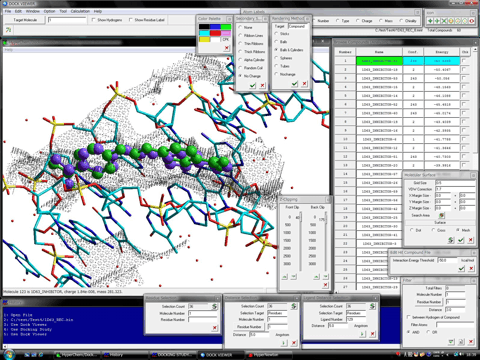
Last Modified
1 January 2024
![]()
Homology Modeling for HyperChem
Homology Modeling Professional for HyperChem, Homology Modeling for HyperChem, ONIOM Interface for Receptor, and Gaussian Interface for HyperChem
What's New in Revision C2.
New Homology Modeling module program supports some logical functions for aligning between sequences derived from plant or insect proteins whose three-dimensional structure have not been solved experimentally.
If the best 3D structure as a template can be found in the PDB database and a multiple sequence alignment is prepared using ClustalW program, the program can give a model for a desired amino acid sequence whose amino acid identity with a template amino acid sequence is less than 15 %.
With improvement of the insertion sequence modeling function, the program can automatically prepare the structure of an insertion part which contains tens of the amino acid residues.
The program supports the point mutation modeling function.
The following shows the addition functions to the previous revision.
Changed the program policy to beginners from hard users of HyperChem (switchable).
Supported the Undo function which is independence on HyperChem.
Supported the PDB format version 3.0-3.3 as well as 2.3.
Supported the precise modeling function for a nucleic acid molecule.
Provided a logical sequence alignment environment.
Supported the automatic modeling function for a conserved S-S bond.
Improved the algorithms in the individual module programs.
Windows Vista compatibility (except for the Aero environment).
Improved the reliability and stability.
Revised the User's manual (Japanese language).
Manual Contents (Japanese Language)
Docking Study with HyperChem
Essential, Premium Essential, Professional, Advanced, and Ultimate
What's New in Revision C1.
The following shows the addition functions to the previous revision.
Supported the automatic nucleic acid- and ligand-flexible docking simulations as well as the protein- and ligand-flexible docking simulations.
The conventional screening option is available for screening compounds (the number of compounds is not restricted).
Changed the program policy to beginners from hard users of HyperChem (switchable).
Supported the Undo function which is independence on HyperChem.
Supported the PDB format version 3.0-3.3 as well as 2.3.
Windows Vista compatibility (except for the Aero environment).
Revised the User's manual (Japanese language).
Manual Contents (Japanese Language)
The following figure shows the results of the nucleic acid- and ligand-flexible docking simulations using the DNA and the minor groove binder. Green structure shows the most stable complex obtained from the docking simulations and purple structure shows the experimentally solved complex.

What's New in Revision C1. 2007/02













